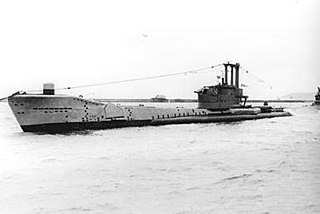
HMS Astute (P447) was an Amphion-class submarine. Her keel was laid down by Vickers at Barrow-in-Furness. She was launched in 1944 and commissioned in 1945.

HMS A9 was an A-class submarine built for the Royal Navy in the first decade of the 20th century. After surviving World War I, she was sold for scrap in 1920.
HMS Acheron (P411) was an Amphion-class submarine of the Royal Navy, laid down 26 August 1944, launched 25 March 1947 and completed in 1948.
HMS Alaric (P441), was an Amphion-class submarine of the Royal Navy, built by Cammell Laird laid down in May 1944 and launched 18 February 1946.

HMS Alcide (P415), was an Amphion-class submarine of the Royal Navy, built by Vickers-Armstrongs and launched 12 April 1945.

HMS Alderney (P416/S66), was an Amphion-class submarine of the Royal Navy, built by Vickers-Armstrongs at Barrow and launched 25 June 1945 by Mrs Molly Wallis, wife of Sir Barnes Wallis. She was the 12th of the class and was scrapped in 1972.

HMS Andrew (P423/S23/S63), was an Amphion-class submarine of the Royal Navy, built by Vickers Armstrong and launched on 6 April 1946.

HMS Amphion (P439), was an Amphion-class submarine of the Royal Navy, built by Vickers Armstrong and launched 31 August 1944.

HMS Auriga (P419/S69), was an Amphion-class submarine of the Royal Navy, built by Vickers Armstrong and launched 29 March 1945.
HMS Anchorite (P422/S22), was an Amphion-class submarine of the Royal Navy, built by Vickers Armstrong and launched 22 January 1946.

HMS Artful (P456), was an Amphion-class submarine of the Royal Navy, built by Scotts Shipbuilding and Engineering Company of Greenock and launched 22 May 1944.
HMS Artemis (P449) was an Amphion-class submarine of the Royal Navy, built by Scotts Shipbuilding & Engineering Co. of Greenock and launched 28 August 1946. The submarine sank while refueling in 1971, was raised and sold for breaking up in 1972.

HMS Narwhal (S03) was a Porpoise-class submarine of the Royal Navy. She was launched on 25 October 1957.

HMS H7 was a British H-class submarine built by the Canadian Vickers Co, Montreal, Quebec, Canada. She was laid down on 19 May 1915 and was commissioned in June 1915. HMS H7 was sold in 1921. It had a complement of twenty-two crew members, a length of 171 feet (52 m), and a surfaced range of 1,600 nautical miles at 10 knots.

HMS H9 was a British H-class submarine built by the Canadian Vickers Co., Montreal. She was laid down on an unknown date and commissioned in June 1915. Launched by J. Grace Gardner at Montréal on 22 May 1915.

HMS H10 was a British H-class submarine built by the Canadian Vickers Co., Montreal. She was laid down on an unknown date and was commissioned in June 1915.

HMS Sea Devil was a S-class submarine of the third batch built for the Royal Navy during World War II. She survived the war and was sold for scrap in 1966.

HNLMS Zwaardvisch (S814) was the lead ship of the Royal Netherlands Navy's Zwaardvisch-class submarine, which was based on the British T class. The submarine was originally ordered as HMS Talent (P322) and built by Vickers Armstrong, Barrow. It served mainly in the Pacific against the Japanese during the war, operating under both British and US operational command in Ceylon and Australia. In 1950, the vessel was renamed HNLMS Zwaardvis. She was sold and broken up for scrap in 1963.

HMS Unrivalled (P45) was a U-class submarine built for the Royal Navy during World War II. The boat has been the only ship of the Royal Navy to ever bear the name Unrivalled. Completed in 1942, the boat spent most of the war in the Mediterranean. She sank a number of small merchant ships and naval auxiliaries, but major success eluded her during the war. Too small and slow for the post-war environment, Unrivalled was scrapped in 1946.
HMS K17 was a British K class submarine built by Vickers in Barrow-in-Furness.














